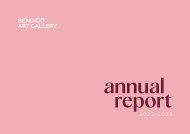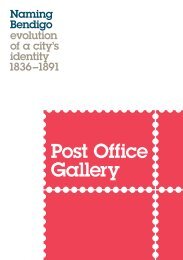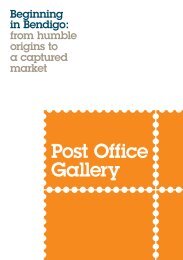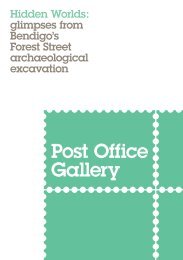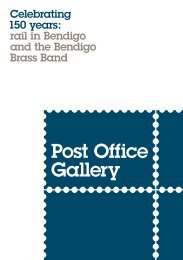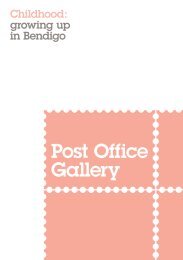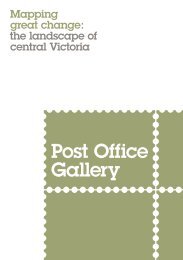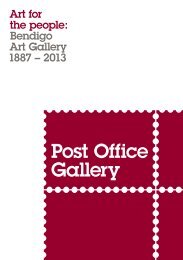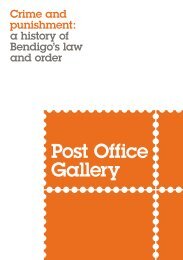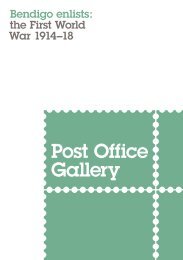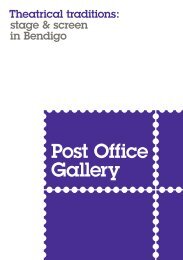A cure for all ills: medicine in Bendigo
This electronic publication accompanies the exhibition A cure for all ills: medicine in Bendigo. From chaotic beginnings to the formation of professional practice, the introduction of regulations against quackery and the establishment of long standing institutions such as Bendigo Hospital, A cure for all ills: medicine in Bendigo explored the social history surrounding the foundations of healthcare in Bendigo and the contribution of doctors, pharmacists, dentists, nurses and Chinese herbalists in providing essential health services to the community.
This electronic publication accompanies the exhibition A cure for all ills: medicine in Bendigo.
From chaotic beginnings to the formation of professional practice, the introduction of regulations against quackery and the establishment of long standing institutions such as Bendigo Hospital, A cure for all ills: medicine in Bendigo explored the social history surrounding the foundations of healthcare in Bendigo and the contribution of doctors, pharmacists, dentists, nurses and Chinese herbalists in providing essential health services to the community.
You also want an ePaper? Increase the reach of your titles
YUMPU automatically turns print PDFs into web optimized ePapers that Google loves.
Previous page:<br />
Hamel and Ferguson<br />
Australia 19th century<br />
Illum<strong>in</strong>ated address<br />
given to Lady Bowen<br />
on the lay<strong>in</strong>g of the<br />
Foundation Stone of the<br />
Bowen W<strong>in</strong>g, <strong>Bendigo</strong><br />
Hospital<br />
1873<br />
paper, cotton,<br />
embossed leather,<br />
<strong>in</strong>k, acrylic pa<strong>in</strong>t<br />
Collection <strong>Bendigo</strong><br />
Health<br />
WH Rob<strong>in</strong>son<br />
Australia 19th century<br />
James Lamsey<br />
1900<br />
gelat<strong>in</strong> silver pr<strong>in</strong>t<br />
Collection Dennis<br />
O’Hoy<br />
<strong>Bendigo</strong> Benevolent Asylum was<br />
opened <strong>in</strong> 1860. Later c<strong>all</strong>ed the<br />
<strong>Bendigo</strong> Home and Hospital <strong>for</strong> the<br />
Aged, the asylum filled an immediate<br />
local need and took pressure off the<br />
hospital.<br />
The ma<strong>in</strong> issue dur<strong>in</strong>g the early<br />
decades of the hospital, and <strong>in</strong>deed<br />
the asylum, was ma<strong>in</strong>ta<strong>in</strong><strong>in</strong>g capital.<br />
A reduction <strong>in</strong> government grants<br />
resulted <strong>in</strong> a significant reliance on<br />
the community to give generously, to<br />
enable essential services to cont<strong>in</strong>ue<br />
to be provided. Despite an <strong>in</strong>itial<br />
lack of <strong>in</strong>terest, the community<br />
ultimately rose to this ch<strong>all</strong>enge with<br />
most of the hospital’s funds com<strong>in</strong>g<br />
from community donations, friendly<br />
societies, schools and annual hospital<br />
subscriptions. In addition, money was<br />
raised each year through charitable<br />
events such as the annual Easter Fair,<br />
established <strong>in</strong> 1871 to raise money <strong>for</strong><br />
both the hospital and the asylum. 12<br />
Another fundrais<strong>in</strong>g measure was<br />
the 1873 <strong>in</strong>troduction of Hospital<br />
Sunday by prom<strong>in</strong>ent <strong>Bendigo</strong>nian<br />
Mr JH Abbott. 13 Inspired by similar<br />
successful events <strong>in</strong> Brita<strong>in</strong>, Hospital<br />
Sunday – like the Easter Fair –<br />
proved to be an effective revenue<br />
raiser. 14<br />
Ancient traditions<br />
While <strong>Bendigo</strong> was establish<strong>in</strong>g<br />
<strong>in</strong>frastructure <strong>for</strong> the practice of<br />
Western <strong>medic<strong>in</strong>e</strong>, among the<br />
Ch<strong>in</strong>ese migrants who came to<br />
the <strong>Bendigo</strong> goldfields <strong>in</strong> pursuit<br />
of gold were those tra<strong>in</strong>ed <strong>in</strong><br />
the ancient traditions of Ch<strong>in</strong>ese<br />
<strong>medic<strong>in</strong>e</strong>. These practitioners<br />
adm<strong>in</strong>istered traditional remedies<br />
to their countrymen, then later to<br />
European migrants who had become<br />
disillusioned with ma<strong>in</strong>stream<br />
doctors and were seek<strong>in</strong>g an<br />
alternative <strong>cure</strong>. Savvy Ch<strong>in</strong>ese<br />
herbalists advertised <strong>in</strong> Englishspeak<strong>in</strong>g<br />
newspapers to attract clients<br />
who would pay good money <strong>for</strong><br />
their services.<br />
In the quest to protect the<br />
<strong>in</strong>terests of the ma<strong>in</strong>stream medical<br />
establishment, it is no surprise<br />
that these ‘<strong>for</strong>eign’ healers were<br />
ostracised. It was considered<br />
acceptable <strong>for</strong> a Ch<strong>in</strong>ese herbalist<br />
to adm<strong>in</strong>ister traditional remedies<br />
to their own countrymen, however<br />
not to treat European clients as<br />
though they were tra<strong>in</strong>ed doctors.<br />
The Victorian Medical Society<br />
discouraged its members from<br />
treat<strong>in</strong>g patients who were also<br />
Ch<strong>in</strong>ese <strong>medic<strong>in</strong>e</strong> bottles<br />
late 19th – early 20th<br />
century<br />
glass, paper, wax<br />
Collection Dennis<br />
O’Hoy<br />
visit<strong>in</strong>g a Ch<strong>in</strong>ese practitioner.<br />
Unregistered, Ch<strong>in</strong>ese herbalists<br />
could not issue death certificates<br />
which could lead to later<br />
implications with coroners and the<br />
law.<br />
The most notable and politic<strong>all</strong>y<br />
active Ch<strong>in</strong>ese herbalist on the<br />
<strong>Bendigo</strong> goldfields was James<br />
Lamsey. Medic<strong>all</strong>y tra<strong>in</strong>ed <strong>in</strong> Ch<strong>in</strong>a<br />
and previously work<strong>in</strong>g <strong>in</strong> the<br />
Canton Hospital, Lamsey arrived<br />
<strong>in</strong> Australia <strong>in</strong> the early 1850s, and<br />
travelled to <strong>Bendigo</strong> <strong>in</strong> the 1870s.<br />
Throughout the late 1800s, there<br />
were numerous attempts by the<br />
Victorian Medical Society to curtail<br />
the activities of Ch<strong>in</strong>ese herbalists.<br />
Several times Lamsey was taken to<br />
court and <strong>in</strong>terrogated <strong>for</strong> operat<strong>in</strong>g<br />
under the illustrious title of doctor. 15<br />
Accord<strong>in</strong>g to local historian Carol<br />
Holsworth, Lamsey and his fellow<br />
herbalists tried regularly to ga<strong>in</strong><br />
registration with the Society but<br />
were denied every time, ‘… not<br />
because of their race or religion, but<br />
because of their lack of anatomical<br />
knowledge and adequate years of<br />
tra<strong>in</strong><strong>in</strong>g.’ 16<br />
Despite be<strong>in</strong>g unsuccessful <strong>in</strong><br />
his campaign to be recognised<br />
as a doctor and to trade under<br />
this title, Lamsey and his fellow<br />
practitioners cont<strong>in</strong>ued their<br />
practices. In a f<strong>in</strong>al ef<strong>for</strong>t to ga<strong>in</strong><br />
professional acknowledgement,<br />
Lamsey tried to become registered<br />
as a pharmacist but was also<br />
unsuccessful. Nonetheless, Lamsey<br />
amassed considerable wealth from<br />
his bus<strong>in</strong>ess activities and ga<strong>in</strong>ed<br />
prom<strong>in</strong>ence <strong>in</strong> both Ch<strong>in</strong>ese and<br />
European circles. 17<br />
Long after Lamsey’s death, th<strong>in</strong>gs<br />
f<strong>in</strong><strong>all</strong>y changed <strong>for</strong> Ch<strong>in</strong>ese herbalists<br />
practic<strong>in</strong>g <strong>in</strong> Victoria when an<br />
amendment to the Pharmaceutical<br />
Chemists Bill was <strong>in</strong>stigated <strong>in</strong> 1925<br />
to regulate the practice of quackery.<br />
Under the title of ‘Herbalists’, it<br />
stated: ‘The several persons named<br />
<strong>in</strong> the schedule to this Act sh<strong>all</strong> be<br />
entitled to cont<strong>in</strong>ue as hereto<strong>for</strong>e<br />
to practice as Herbalists or Herbal<br />
Practitioners and to use the title of<br />
Herbalist or Herbal Practitioner and<br />
to mix prepare and supply medic<strong>in</strong>al<br />
herbs and to give directions <strong>for</strong><br />
their use to persons under their<br />
personal care or treatment ...’ 18 This<br />
amendment was accompanied by a<br />
list of practitioners, <strong>in</strong>clud<strong>in</strong>g several<br />
herbalists from <strong>Bendigo</strong>. 19<br />
10 11




